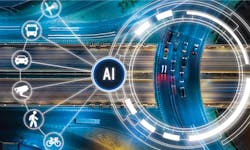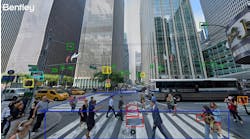By Sherry Kish, Contributing Author
Artificial intelligence (AI) is playing a significant role in the transportation industry’s drive toward Vision Zero, a strategy that entails vehicle and infrastructure safety improvements to deliver a road network with no fatalities.
As a tool, AI continues to advance work zone safety outcomes, mitigate crashes at intersections and improve mobility for pedestrians and bicyclists that share the road with vehicles. Automated vehicles and other emerging transportation technologies are beginning to utilize AI to further safety benefits.
AI also can capture monumental amounts of transportation-related data and present it in dashboards that allow traffic management centers to garner relevant and actionable information to make the best real-time decisions and to better inform future planning.
As transportation agencies nationwide begin to implement AI technologies in practical ways, the industry is learning how to best address common and location-specific safety challenges. Examples of these real-world applications include crash prediction and proactive mitigation, work zone safety, traffic prediction and congestion reduction, roadway maintenance detection and dispatch and route optimization.
Crash prediction and proactive mitigation: Intersection crashes are most frequently caused by drivers running red lights. Using AI, sensors leading up to intersections can detect vehicles that will run red lights and delay changing the traffic signals. Holding the opposing green light for two or more seconds has the ability to reduce these crashes.
In another example, AI’s data integration and pattern recognition capabilities could compare intersection crash data with other intersection data to yield new insights about the impact of factors like nonworking signals on accidents.
Work zone safety: Construction workers are especially at risk in work zones. Embedding location-tracking devices in workers’ vests allows their positions to be tracked relative to traffic. AI technologies can then optimize routes for drivers to avoid workers or dynamically adjust notifications to drivers based on real-time data and patterns.
Traffic prediction and congestion reduction: AI can interpret past roadway data and overlay other influences to help transportation agencies predict how infrastructure will perform under certain conditions.
AI can blend real-time roadway and weather data, for instance, to show when roads are likely to flood, giving transportation organizations a chance to send early notifications through their traffic messaging systems.
AI also can combine multiple scenarios to predict, for example, that a weather pattern will cause certain types of traffic congestion or other challenges. That advance awareness dramatically increases traffic management organizations’ ability to efficiently address outcomes of the weather event, increasing safety.
Roadway maintenance detection and dispatch: Processing historical roadway data alongside lidar and camera images of guardrails, signs and roadway surfaces, AI can quickly identify, prioritize and specify road maintenance needs, allowing governments to make more accurate procurement decisions.
Historical data can be used to better predict future needs. Multijurisdictional AI use could help governments create efficiencies by managing maintenance, dispatch and inventory at a statewide or citywide level.
Route optimization: This increases vehicle and driver safety and reduces travel time. AI analyzes real-time road threats, traffic flow and predictive analytics to generate ideal routes and, as needed, make mid-route adjustments.
AI Implementation
AI’s potential to improve transportation safety is compelling. Learning how and when to implement AI is essential. This education is necessary to ensure that leaders can effectively conduct AI tool research and source, evaluate and procure software that delivers viable, actionable solutions.
Transportation agencies setting out to tap into AI’s benefits may consider the following when crafting AI policies and strategies:
- Data governance: Questions of data security and data privacy are inherent in AI use. Governance is needed to establish what data is available and how data is to be used. Policies and standards should clarify who holds oversight and decision-making responsibility, who can use the technology internally and how the AI data output is managed.
- Data quality: An AI system’s output is only as good as the data on which it is trained. The governance document should define and detail expectations for data quality, which generally refers to data that is accurate and complete, error free, up to date, equitable, uniform and applicable to the specific context or purpose.
- Testing and Validation: A test period is important to ensure the AI product will perform as anticipated. Testing time can be built into a contract with a software provider, or a nondisclosure agreement may allow testing to occur even before a purchase is made. Trying out the software allows agencies to determine whether it will effectively address organization-specific transportation challenges.
- Training and transparency: When AI is introduced, transparency and training are essential to ensure its proper use. Staff members need to understand the business objective behind the AI system implementation, what problem it is expected to solve and what tasks it will perform.
Training is needed to ensure data quality and teach users how to operate the software correctly, but also prepare them for any changes AI may introduce, like the automation of routine tasks that managers and their teams must be ready for and equipped to handle.
Transparency also needs to come from any vendor through an explanation of how their solution works. Transportation agencies need to understand what data is being used to ensure the outcomes are reliable and equitable.
- Equity: To achieve equitable output from AI initiatives, data quality needs to be equitable from the beginning, purposefully and adequately representing all users of transportation projects.
- Human oversight: AI will serve agencies and their constituents effectively only if its applications are filtered through the human perspective. AI is a powerful tool in the industry’s tool belt, but users and overseers must evaluate projects and outputs to be sure AI is delivering actionable insights or high-value solutions to real and pressing transportation challenges. People utilizing AI are responsible and accountable for the work product it develops.
Guidance for AI Use
Successful decision-making around AI demands a foundational understanding of what it is and how its capabilities can serve transportation organizations and their constituents. To advance the discussion around the implementation of AI, the federal government has developed AI guidelines and a website for federal agencies to share how they are using AI.
This information sharing on a national level accelerates opportunities for others to understand best practices and avoid pitfalls.
Collaboration between public and private sectors — partnerships with academic institutions, tech companies and public agencies — also can help accelerate innovative solutions and then distribute the necessary expertise that is crucial for the success of AI in transportation.
Implementation of AI is a complex journey. With a laser focus on learning, policy and strategy, transportation agencies can navigate the path to successful AI implementation, leading to a smarter, more equitable and safer transportation system for all. RB
Sherry Kish, Esq., is a National Practice Consultant for HNTB.



